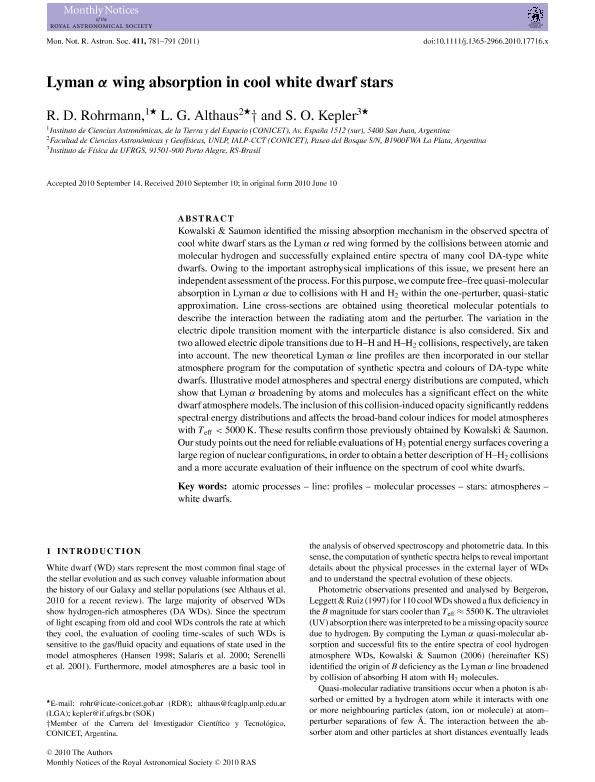Mostrar el registro sencillo del ítem
dc.contributor.author
Rohrmann, Rene Daniel

dc.contributor.author
Althaus, Leandro Gabriel

dc.contributor.author
Kepler, S. O.
dc.date.available
2016-12-19T15:27:26Z
dc.date.issued
2011-02
dc.identifier.citation
Rohrmann, Rene Daniel; Althaus, Leandro Gabriel; Kepler, S. O.; Lyman-alpha wing absorption in cool white dwarf stars; Wiley; Monthly Notices Of The Royal Astronomical Society; 411; 2-2011; 781-791
dc.identifier.issn
0035-8711
dc.identifier.uri
http://hdl.handle.net/11336/9712
dc.description.abstract
Kowalski & Saumon identified the missing absorption mechanism in the observed spectra of cool white dwarf stars as the Lyman α red wing formed by the collisions between atomic and molecular hydrogen and successfully explained entire spectra of many cool DA-type white dwarfs. Owing to the important astrophysical implications of this issue, we present here an independent assessment of the process. For this purpose, we compute free–free quasi-molecular absorption in Lyman α due to collisions with H and H2 within the one-perturber, quasi-static
approximation. Line cross-sections are obtained using theoretical molecular potentials to describe the interaction between the radiating atom and the perturber. The variation in the electric dipole transition moment with the interparticle distance is also considered. Six and two allowed electric dipole transitions due to H–H and H–H2 collisions, respectively, are taken into account. The new theoretical Lyman α line profiles are then incorporated in our stellar atmosphere program for the computation of synthetic spectra and colours of DA-type white dwarfs. Illustrative model atmospheres and spectral energy distributions are computed, which show that Lyman α broadening by atoms and molecules has a significant effect on the white dwarf atmosphere models. The inclusion of this collision-induced opacity significantly reddens spectral energy distributions and affects the broad-band colour indices for model atmospheres with Teff < 5000 K. These results confirm those previously obtained by Kowalski & Saumon. Our study points out the need for reliable evaluations of H3 potential energy surfaces covering a large region of nuclear configurations, in order to obtain a better description of H–H2 collisions and a more accurate evaluation of their influence on the spectrum of cool white dwarfs.
dc.format
application/pdf
dc.language.iso
eng
dc.publisher
Wiley

dc.rights
info:eu-repo/semantics/openAccess
dc.rights.uri
https://creativecommons.org/licenses/by-nc-sa/2.5/ar/
dc.subject
Absortion Lines
dc.subject
Atmospheres of Stars
dc.subject
Atomic Processes
dc.subject
Molecular Processes
dc.subject
White Dwarfs
dc.subject.classification
Astronomía

dc.subject.classification
Ciencias Físicas

dc.subject.classification
CIENCIAS NATURALES Y EXACTAS

dc.title
Lyman-alpha wing absorption in cool white dwarf stars
dc.type
info:eu-repo/semantics/article
dc.type
info:ar-repo/semantics/artículo
dc.type
info:eu-repo/semantics/publishedVersion
dc.date.updated
2016-12-14T15:25:45Z
dc.journal.volume
411
dc.journal.pagination
781-791
dc.journal.pais
Reino Unido

dc.journal.ciudad
London
dc.description.fil
Fil: Rohrmann, Rene Daniel. Consejo Nacional de Investigaciones CientiÂficas y Tecnicas. Centro Cientifico Tecnologico San Juan. Instituto de Ciencias Astronomicas de la Tierra y del Espacio; Argentina
dc.description.fil
Fil: Althaus, Leandro Gabriel. Consejo Nacional de Investigaciones Científicas y Técnicas. Centro Científico Tecnológico La Plata. Instituto de Astrofísica de La Plata; Argentina. Universidad Nacional de la Plata. Facultad de Ciencias Astronómicas y Geofísicas; Argentina
dc.description.fil
Fil: Kepler, S. O.. Universidade Federal do Rio Grande do Sul; Brasil
dc.journal.title
Monthly Notices Of The Royal Astronomical Society

dc.relation.alternativeid
info:eu-repo/semantics/altIdentifier/arxiv/http://dx.doi.org/10.1111/j.1365-2966.2010.17716.x
dc.relation.alternativeid
info:eu-repo/semantics/altIdentifier/url/http://mnras.oxfordjournals.org/content/411/2/781
Archivos asociados
